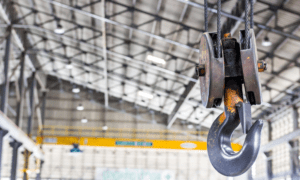
Overhead cranes are complex machines that rely on several different systems working together to move materials safely and effectively around the plant, factory, and job site. There are many reasons why your overhead crane suddenly needs emergency services or repairs.
However, several steps can be taken to minimize these costs, negatively impacting worker productivity, safety, and the company’s bottom line. As a result, it is essential to reduce the impact of planned maintenance and eliminate the need for emergency repairs as much as possible. To help you achieve this goal, we’ve asked the Hi-Speed Team to share their best tips and strategies for minimizing unexpected and emergency repairs for overhead cranes.
Review the User Manual
One of the most common reasons for overhead crane repairs is operator error or misuse. While many cranes utilize similar components, such as the trolley, hoist, cable, and hook, these can be easily damaged when used incorrectly. The user manual may outline the correct rigging and lifting procedures based on the specific components used for each crane.
Any employees working around or near the crane should be familiar with the correct loading, lifting, moving, and lowering procedures. These workers can act as additional eyes and ears for the operator while the crane is in use. The user guide will also include the manufacturer’s recommendations for crane inspections, scheduled maintenance, and the proper lubricants to maximize crane longevity and performance.
Understand Duty Cycle Restrictions
Overhead cranes are rated into classes A through F, depending on their anticipated loads and usage. Crane operators must adhere to the specific duty cycle restrictions to avoid damaging the crane’s components. If you’re unsure about your crane’s duty cycle, the CMAA (Crane Manufacturers’ Association of America) provides universally accepted guidelines to determine a crane’s duty cycle.
CMAA 70 – Specifications for Top Running Bridge and Gantry Type Multiple Girder Electric Overhead Cranes
CMAA 74 – Specifications for Top Running & Under Running Single Girder Electric Traveling Cranes Utilizing Under Running Trolley Hoist
Overloading and excessive use will push the components beyond their engineered standards, resulting in excessive wear, unexpected breakage, and emergency repair costs.
Regular Crane Inspections
OSHA guidelines require that every crane be inspected annually, with the dated reports stored for future reference. However, more frequent inspections, such as quarterly, monthly, or daily, can help reduce excessive downtime for maintenance and repairs.
Per OSHA 29 CFR 1910.179, many crane components are included in the inspection process, but here is a general checklist that most companies can use or adapt depending on the type of crane used.
Horns: Cab-controlled cranes and those that use radio controls must have horns (audible alert) to warn nearby workers that a load is moving.
Warning Lights: Cab-controlled cranes must also have flashing, colored, or strobe lights to alert nearby workers visually that the crane is in operation.
Crane Lights: Typically mounted to the underside or structure of a crane to increase the visibility of the floor, nearby workers, and potential crane hazards.
Limit Switches: Slow the trolley’s travel before hitting the end stops to prevent damage to the crane and runway. The pre-programmed limits can also alert the operator that the crane is approaching an obstacle or stopping point.
Walkways: Typically added to a crane to provide access to the operator and maintenance personnel, walkways should be inspected regularly for potential trip hazards or excessive wear. An additional employee must monitor their use from the ground, and walkways do not eliminate the need for fall protection.
Overload Sensors: These devices report the actual load weight lifted to the operator. Maintenance and service technicians can use the captured data for future troubleshooting and repairs.
Radio Control: Improve operator safety since the crane is operated remotely instead of using a pendant (tethered) control unit. Today’s units also feature two-way communication, allowing the device to send and receive operational commands and data.
Collision Avoidance Systems: Track and monitor each crane on the runway to avoid collisions with the end-stops, obstructions, and other crane(s).
Brake Slip Monitoring: These systems document brake slippage for future troubleshooting or repairs and alert operators and service teams when an adjustment is needed.
Variable Speed Drives: Provide smoother starts and stops to eliminate load swings from hard starts and sudden stops while reducing mechanical wear and drive train impact loads.
Standardized pre-checks of the hook, cable, trolley, and hoists should occur daily or at the start of each shift to further avoid the need for emergency repairs, unexpected downtime, and their impact on the company’s productivity and profitability.
Let Hi-Speed help you ensure maximum crane uptime and worker safety with regular inspection contracts to identify potential problems before they require replacement parts or repairs. You can email the Hi-Speed Crane Experts to learn more or call us today at 800-713-0103.

